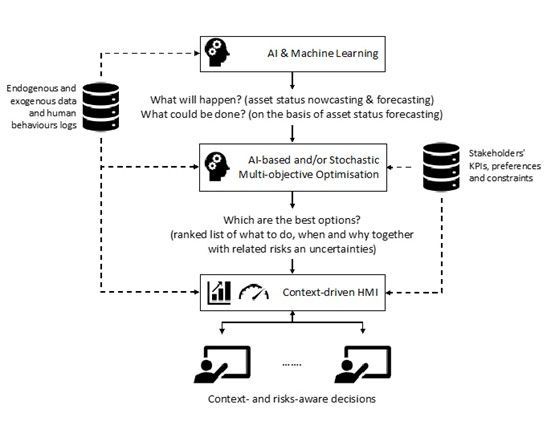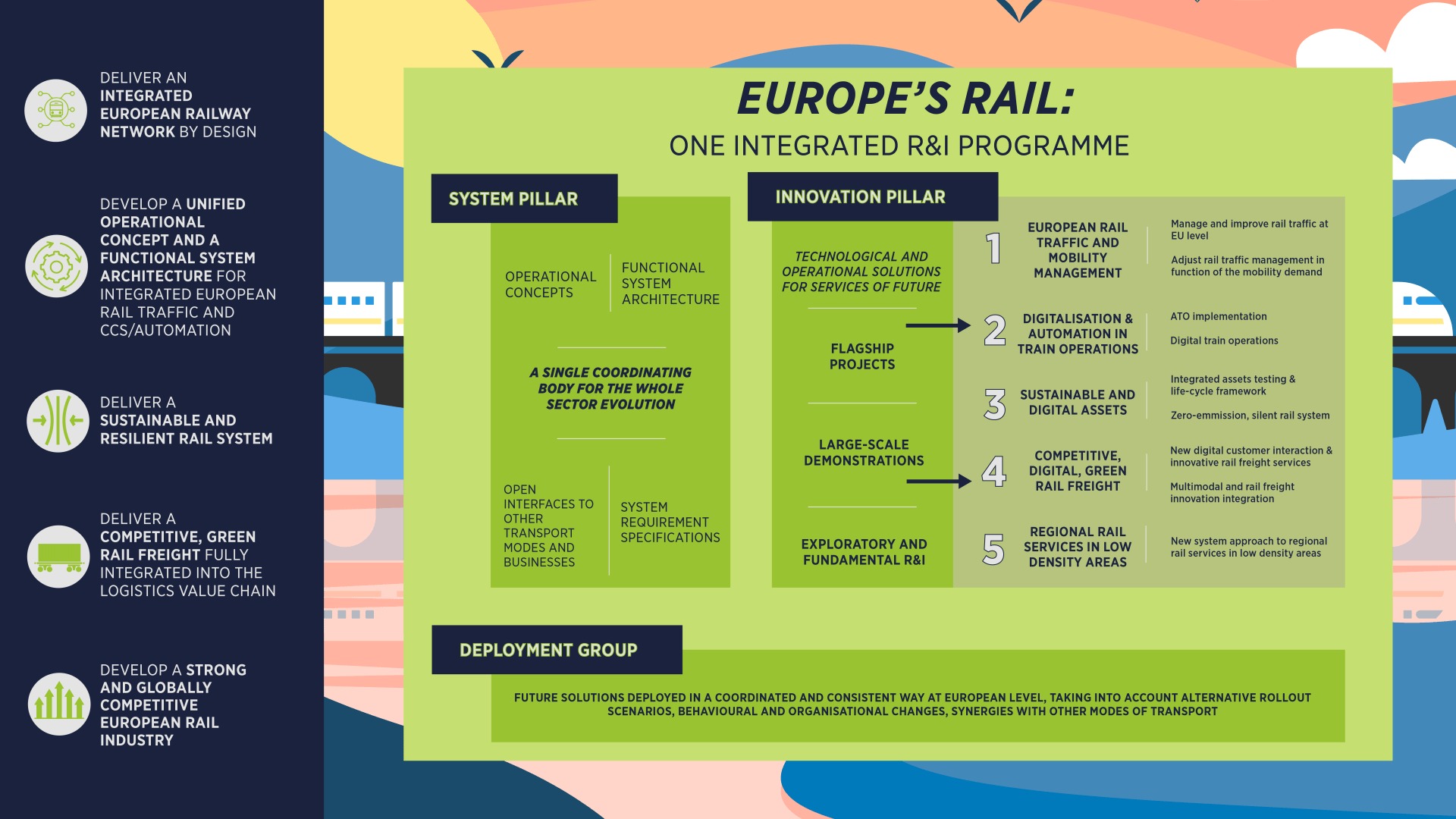BTOB IOT & AI IN MOBILITY
Research and Innovation
Keeps AI on the Right Track


Love it or fear it, Artificial Intelligence is here. But while the headlines are focused on new developments in generative AI, this emerging technology is also making waves in the rail sector.
Artificial intelligence (AI) could prove to be nothing short of a gamechanger for the rail industry. Not only does it have the potential to optimise complex railway systems, improve the safety and security of urban rail networks, and enhance the customer experience, it can also help manage capacity and lifecycle costs, streamline maintenance activities, and reduce the risk of errors – all while bringing a high-level of automation to rail operations.
“Within this context, AI represents a paradigm shift for European rail,” says Europe’s Rail Executive Director Carlo Borghini. “Because it can help solve the critical challenges that railways face today, I predict that it will eventually become a ubiquitous tool used across the industry.”
While AI’s potential within the rail sector is evident, as of now, it is still only that: potential. Is the technology itself still very much in its infancy in rail?
Bridging the gap between potential and real-world application is research and innovation, including that being supported by Europe’s Rail.
Europe’s Rail is the European partnership on rail research and innovation. Through funding, knowledge sharing, and support, it’s accelerating the development of transformative technologies and operational solutions that will redefine the sector. “Tackling the complexities of rail while maximising its many benefits starts with forward-looking, cutting-edge, integrated, and systemic research and innovation,” adds Borghini.
AI Solutions for Predictive and Prescriptive Rail Maintenance
A prime example of what that forward-looking research looks like can be seen in the development of AI solutions for railway maintenance. Here, Europe’s Rail is supporting a number of initiatives that are moving the needle away from preventive and condition-based maintenance towards predictive and prescriptive maintenance. The main difference being that whereas preventive maintenance is scheduled regularly, predictive maintenance occurs on an as needed basis.
How do you know when a track or other piece of equipment needs work? AI can tell you. “Given the amount of available data, we can now move towards data-driven methods that rely on historical and/or real-time data to diagnose faults and defects and predict – and ultimately avoid – possible failures,” says Stefanos Gogos, with the project coordinator of the DAYDREAMS project.
DAYDREAMS is a Europe’s Rail supported research initiative developing a suite of technologies to solve fundamental, multi-objective railway maintenance problems. This includes the use of AI and machine learning for modelling the entire maintenance process.
The project’s technologies utilise endogenous and exogenous (e.g., environmental) data, asset-related physical models, and data on human behaviour and actions to predict what will happen to a particular asset and what should be done to remedy the issue. The project also uses AI to rank all possible solutions based on related risks and uncertainties and taking into account stakeholder and maintenance process metrics and constraints – allowing for more informed decision-making.
As Gogos explains, AI solutions will enable maintenance engineers to carry out inspections and diagnostic activities more time- and cost-efficiently and with more accuracy. They can also support dynamic activity planning and maintenance automation. “Our mathematical modelling tools not only predict when an issue is likely to occur but can also help balance maintenance needs with service continuity,” he says.
For example, the ability to predict and fix a future defect before it becomes an issue gives maintenance engineers the flexibility to schedule work when it will cause the least amount of disruption to service. Furthermore, these same algorithms can be used to model any delays that maintenance work will cause and automatically identify alternative routes and modes of transport.
“The beauty of AI is it allows us to mitigate the impact maintenance has on passengers without sacrificing track safety,” adds Gogos.

There’s No AI without
Quality Data
AI’s role as a predictive tool is by no means limited to maintenance – it can also be used to predict peaks in passenger demand, cancellations, and delays. As to the latter, the Europe’s Rail supported IN2RAIL project is using advanced algorithms to analyse historical train data, along with current weather forecasts, to predict potential delays.
AI algorithms can also combine weather data with data on soil conditions to predict issues with slope stability and the potential risk for landslides. Or, by leveraging track, vehicle, and wind data, it can analyse the risk of derailment.
Of course, the key word here is ‘data’. “Providing quality and trustworthy data has always been one of the main challenges to characterising AI models,” explains Gorazd Marinic, a Programme Manager at Europe’s Rail. “Being able to collect up-to-date, good quality and well structured data, filtered to specific tasks, would allow us to improve existing models and build more advanced ones.”
To this end, emerging ad-hoc wireless sensor networks, such as the ones based on Internet of Things (IoT) devices, can contribute to the ever-increasing real-time streams of data coming from different sources. For instance, connected devices like smart cameras, together with sensors, can be used to ensure issues at level crossings are detected early. The Europe’s Rail funded RAILS project is investigating the effectiveness of AI approaches to evaluate the health status of level crossing while leveraging data from cameras and microphones.
Just Scratching the Surface
While predictivity tends to be a priority of much of today’s research, this is really just scratching the surface of what AI is capable of. In fact, AI will play an important role across all Europe’s Rail’s flagship areas, including safety and security, autonomous driving and control, transport planning, sustainability, and passenger mobility, amongst others – which is why the organisation is actively supporting research in each.
As for safety and security, initiatives like the SMART project are using AI to detect on-track obstacles that could cause accidents and possibly injury to passengers. Its innovative obstacle detection solution, called SMART OD, is a multi-sensor on-board system that combines different sensor technologies (thermal, night vision, and multi RGB cameras). Mounted to a locomotive, these sensors can detect obstacles beyond 200m, the current state-of-art, and up to 1000m.
The images and data are then analysed by a machine learning tool, which automatically classifies the size and type of obstacle (i.e., human, animal, vehicle, rockslide, etc.) and calculates the distance between the train and said obstacle, allowing the operator to take corrective action.
According to Valeria Vittorini, coordinator of the RAILS project, this ability to automatically detect obstacles is an important first step towards the autonomous driving and control of trains. “The goal is to move towards automatic train control functionalities that will allow trains to self-adapt and communicate, ultimately leading to the implementation of autonomous control features,” she says.
“Advanced on-board obstacle detection systems, which allow the train to autonomously run from station to station, are key enablers for this transition.” The RAILS project, which received funding from Europe’s Rail, is investigating the potential of AI approaches in the rail sector and is defining roadmaps for future research in next generation signalling systems, operational intelligence, and network management.
Advancing Automation, Enhancing Efficiency, and Improving the Passenger Experience
Beyond obstacle detection, AI is being used to overcome challenges related to train positioning, a key hurdle to the automatization of train movements. “Safe train positioning is a challenging task but one that could boost rail performance and enable cost reduction in terms of train detection infrastructure like balises and circuits,” explains Javier Goikoetxea, TAURO project coordinator.
The challenge is that many of the prominent technologies used for localisation and positioning, namely satellite navigation and inertial sensors, aren’t well-suited for the harsh railway environment.
According to Goikoetxea, Simultaneous Localisation and Mapping (SLAM) – AI algorithms based on radars and/or lidar sensors – could help solve rail’s positioning problem. “Radars and lidars are already being used on trains for object detection and collision avoidance systems, so it makes sense to exploit their full potential as much as possible,” he adds.
To test SLAM’s feasibility as a potential positioning solution, the TAURO project has mounted sensors on a tram and is performing positioning algorithms both in real-time and during post-processing. “Once tested and validated, these technologies will complement existing solutions and, together, will help provide the safe train positioning needed to further rail’s automatization,” notes Goikoetxea.
This same focus on automatization can also help optimise rail’s energy efficiency. For instance, the Europe’s Rail supported OPEUS project has developed an energy simulation model that uses case studies to assess the energy impact of new technologies and innovations applied to rolling stock. Decision-makers can use the tool to make more informed decisions about selecting technologies that improve a rail vehicle’s energy performance.
“This tool must could be the basis on which to build the accurate, inclusive, and integrated platform that would enable further improvement to rail’s already excellent energy use record,” says OPEUS project coordinator Prof Roberto Palacin.AI is even automating the passenger experience. For example, the Europe’s Rail My-TRAC project is using AI to analyse traveller behaviour. This data is then translated into various services – many of which are made available via an intuitive user interface that provides passengers with up-to-date information, multimodal travel suggestions, and tailored recommendations.
“Our novel transport services platform improves the passenger experience by combining advanced behavioural transport analytics and AI algorithms,” says Europe’s Rail Programme Manager, Gorazd Marinic “All of this is backed by a smartphone application to connect information coming from public transport operators, mobility as a service providers, and datasets related to the service and the journey.”
From Emerging to Converging
More efficient and frequent rail services, less disruptions, lower environmental impact, and reduced lifecycle costs – AI is the key to unlocking a more efficient, sustainable, and competitive rail sector.
However, for this to happen, research and innovation cannot be done in silos. Instead, the technologies and solutions that are being developed across countries, institutions, industries, and sectors must all come together.
“Up to now, research has focused on emerging technologies – developing AI and machine learning algorithms and IoT devices and sensors, etc.,” concludes Marinic. “Our focus must now shift to the convergence of such technologies, where individual solutions become integrated, their use becomes seamless, innovation accelerates and and their impact monumental. This should become a key component of the system architecture design performed within the System Pillar too”






